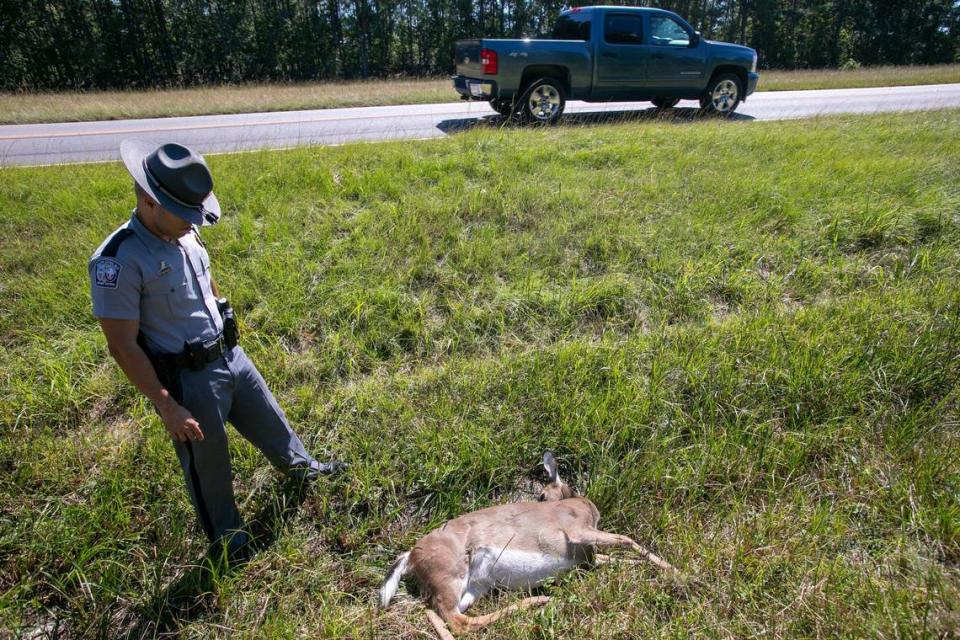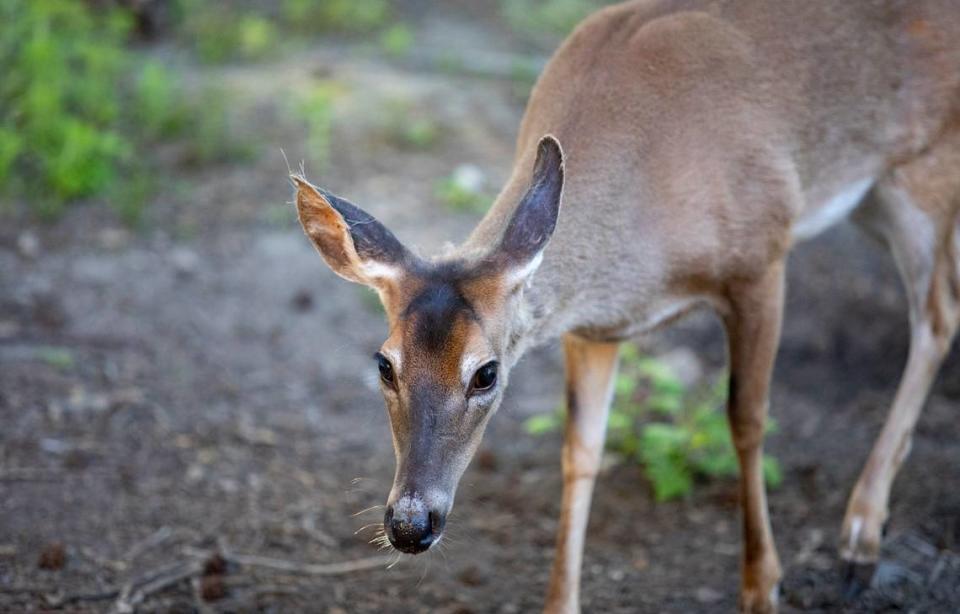With vehicle-deer crashes rising rapidly, these Horry County spots are most dangerous
Passing Broadway at the Beach, it’s easy to get distracted by the bright lights of the SkyWheel and Ripley’s Believe It or Not!
However, drivers need to keep a closer eye out for 150-pound hazards crossing the road: deer.
In the past decade, vehicular collisions with deer have become increasing common across South Carolina, especially in places with rapidly growing populations like Horry County.
Deer related collisions in Horry County nearly quadrupled from 87 in 2012 to 340 in 2019 before declining to 286 in 2020, according to Highway Patrol data. Across the state, crashes increased from 2,291 in 2012 to 3,086 in 2019. DNR says the 2020 drop can be attributed to fewer drivers on the road during the pandemic.
The number of deaths statewide from these crashes rose slightly as well, from five in 2012 to 8 in 2019.
While most of these accidents only result in property damage, some turn out to be deadly — both for the deer and the humans involved.
The Sun News analyzed Highway Patrol data for vehicle-deer collisions for the last three years and mapped where each crash occurred and when.
Many crashes happen in the rural parts of the county on small two-lane highways. But these accidents are not just happening out in the middle of nowhere; many of them are happening in highly populated areas: on Kings Highway in downtown Myrtle Beach, by Coastal Grand Mall and across the street from Broadway at the Beach.
One crash last August happened in a North Strand neighborhood just blocks away from Duplin Winery. S.C. Highway 31 — with the highest speed limit in the region — recorded one vehicle-deer crash for almost every mile of road with 28 accidents. S.C. Highway 22, which connects many rural parts of the county together, is even worse with 46 accidents.
S.C. Highways 9 and 905 along with U.S. Highway 501 are also dangerous areas for deer crossings. U.S. Highway 17 Bypass in Myrtle Beach is one of the most common spots for accidents in an urban area. The entire region around Conway, as well, has also been littered with many deer carcasses over the last three years.
All of these crashes are happening as the state’s deer population is actually declining. Since it height in 2000 of nearly 1 million, so many deer that they become a problem, South Carolina’s deer population has fallen by 25% to between 730,000 and 750,000, according to DNR.
Rising crashes
If the deer population declined so much, how are there so many more crashes happening?
Rapid population growth in the state’s urban areas, leading to suburban sprawl, has turned my deer habitats into human habitats, said Charles Ruth, the S.C. Department of Natural Resources’ senior big-game biologist. The problem is worse in places like Horry County, which has a large volume of new residents moving from large metropolitan areas like Philadelphia, New York City and New Jersey, where drivers are less likely to have experience with four-legged, white-tailed road hazards.
On the southwestern side of the state, Allendale County has an opposite situation to Horry County. It has one of the largest deer populations in the state but very few accidents involving them, Ruth said.
This happens for two reasons. First, Allendale’s population is just over 9,000 people, 2.5% of Horry County’s population. There are fewer people and fewer cars. Second, the people who do live there are used to the deer population, unlike those who live in Horry County, Ruth said. They know to constantly keep an eye out, especially at night.
“Vehicle collisions are very low simply because there’s nobody there to run into them,” Ruth said of Allendale. “Horry County is not known for deer hunting. You’ve got deer, but it’s not a destination for deer hunting. So in spite of a moderate deer population, because there are so many people and so many roads and so many the vehicles, you end up with a bunch of deer-vehicle collisions.”

For Horry County, Ruth said the deer problem is only going to get worse.
The county has been one of the top three fastest-growing areas in the state for years. It’s also one of the fastest-growing counties in the nation. Many of those new residents come from densely populated Pennsylvania, New York and New Jersey, according to an analysis by WBTW News 13.
“As the county continues to develop, including more people, more roads, more vehicles, you will see that trend increase,” Ruth said. “You may have a situation where, coincidental with development, you got the same number of deer and less space, less green space for the deer to be in, which may give the appearance that there’s more deer in a certain area. But it’s just they’re crowded a little bit more.”
The issue, while particularly bad in Horry County, isn’t limited to the area. Ruth said Columbia and Greenville have seen similar growing problems as those cities grow and spread out as well.
Dangerous seasons
Deer aren’t just flooding into the streets all year round. There are a few months that serve as peak times for our white-tailed friends winding up in front of your headlights.
Late September through early December is when approximately half of all deer collisions occur. This lines up with their mating season, from mid-October to mid-November and the start of hunting season.
Deer are also more likely to roam at dawn and dusk, which presents a particularly difficult hazard for people.
“That kind of sets people up to fail because it’s commuting time for a lot of folks,” Ruth said. “It just lines up in the fall where human activity, deer activity, they come together.”
What to do if you see Bambi
You’re driving down Highway 17 Bypass, glancing at the SkyWheel. Suddenly, a deer walks into view. What to do depends on how far away it is, Ruth said.
If the deer is rather far away and there are not many cars around, flip your brights on, slow down and honk. Ruth said this should warn the deer of danger and hopefully deter it from crossing the road or getting off the road if it’s already there. AAA travel company echoes this advice and reminds drivers to always have their seat belt on, as well.
If the deer is close (i.e. you’re within a few seconds of passing it), do none of those things. Just keep driving. At that point, Ruth said, bright lights or loud noise could startle the deer into the road from the shoulder.

If the deer is close and directly in front of you, Ruth says keep driving. Don’t try to swerve or dodge the deer. Just hit it. Most accidents involving deer are property damage only; more dangerous situations occur when drivers try to avoid the deer and end up hitting another car or run off the road and hit a tree.
“If a collision with a deer is imminent, hit the deer. Do not try to avoid it,” Ruth said. “Where people get into trouble is where when they are spontaneous or instinctually react and lose control of the vehicle, and they hit a tree or some other immovable object or end up in a ditch. That’s when these catastrophic situations happen.”
Also, if one deer passes, that doesn’t mean the road is suddenly clear. Where there is one deer, Ruth said, there are probably more.
What to do if you hit Bambi
Depending on the severity of the accident, Ruth recommends calling local or state law enforcement, as you’ll probably need the police report for an insurance claim.
Reporting the accident also helps S.C. Highway Patrol keep an eye on which areas deer are most likely to cross. If they see a lot of crashes happening in one spot, Ruth said, the state might add a “deer crossing” sign.
However, he added that deer crossing signs only denote general areas where deer might cross.
“There’s a lot of folks out there that think the deer are going across where that sign is,” he said. “I get calls all the time. Why don’t they move that sign so the deer will cross somewhere else?
“People need to understand that those deer crossing signs don’t indicate a specific crossing. They’re indicating an area, a stretch of road way where collisions have been frequent.”
So, if you’ve hit it, the deer is now dead, probably. If it isn’t, it will probably die soon, as being hit by a car is a pretty traumatic event for them physically, Ruth said.
Some might wonder, and many people call DNR to ask — can you keep the deer? (For food, we mean.)
In South Carolina, Ruth said, the answer is yes. That’s not the case in every state. Texas, for example, does not allow people to keep deer hit by cars outside of hunting season or if they lack a hunting license.
“But you really need to have that incident report so everybody knows what happened, that it was a deer-vehicle collision, and you didn’t illegally harvest the deer out of season,” Ruth said.

